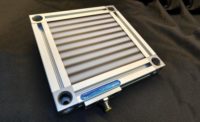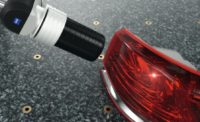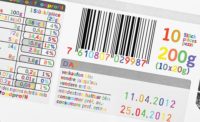Machine Vision: Inspecting Reflective Surfaces with Deflectometry
Reliable detection of even the tiniest scratches.

Deflectometry allows scratches on a vehicle body to be reliably detected. Source: MVTec Software GmbH
Machine vision processes have become standard practice in quality assurance. Inspecting reflective surfaces, however, presents a challenge. A technology known as deflectometry can be used to reliably detect all types of defect even in these circumstances.
Machine vision is used today in many quality assurance applications. The technology can reliably identify products with manufacturing defects using optical methods. Cameras record the objects to be inspected from different perspectives and generate large amounts of digital image data. This data is then processed by integrated machine vision software and used to detect faults, making it possible to automatically remove rejects before they enter the downstream logistics process chain. This method is used in all manufacturing industries, including mechanical engineering, food and beverage, pharmaceuticals, and electronics.
Ensuring the highest quality standards in automotive engineering
However, machine vision reaches its limits when it comes to inspecting very smooth, reflective surfaces. This especially applies in all cases where the visual appearance of certain objects is crucial. One classic example is automotive engineering, where chrome-plated parts and the painted surfaces of car bodies must meet the highest aesthetic standards. Even the tiniest scratch in the paint of a new car can mar its appearance and cause the vehicle to drop in value. The same is true in other industries, such as consumer goods, microelectronics, and household appliances, where the manufactured products contain sensitive components made of glass, plastic, ceramic, or polished metals. The displays and reflective surfaces of smartphones and tablets, for example, must be meticulously inspected to satisfy the highest quality standards. This also applies to shiny metallic or gold-plated doorknobs and handles.
Due to the light reflecting off these surfaces, conventional machine vision systems are unable to process image information accurately and detect defects reliably. A state-of-the-art technology known as deflectometry can remedy this situation. It allows both flat and curved reflective surfaces to be inspected optimally and all types of defect to be identified quickly and reliably.

Deflectometry is ideal for inspecting shiny, reflective surfaces. Source: MVTec Software GmbH
Precisely detecting and locating defects
So how does this process work? An image acquisition unit, such as a USB3 Vision- or GenICam-compatible industrial camera, records digital image data from the reflective object to be inspected. A monitor is positioned diagonally across from the camera and simultaneously displays a sequence of striped patterns, which are reflected onto the surface and are visible in the recorded images. Based on the light reflections, the machine vision software calculates precisely where uneven areas are located on the object surface. As a result, even the tiniest defects that are invisible to the naked eye, such as scratches, bumps, cracks, dents, and air inclusions, can be accurately detected and located.
The main benefit of deflectometry is that it is more reliable in detecting faults of this type on reflective surfaces than any other technology. Companies can take advantage of this benefit at a competitive price. For example, they may use deflectometry features that are already included in standard machine vision software. Moreover, the components for these inspection tasks—consisting of a camera, monitor, PC, and software—are available for less than $6,000. By comparison, a company would have to invest up to six times as much to purchase a complete deflectometry system.
Conclusion
The automated inspection of smooth, reflective surfaces is a difficult problem to solve. Deflectometry methods can help remedy this situation. Such functions are already included in modern machine vision solutions, which helps place the detection of defects and thus quality assurance on a firm footing in this context.
Looking for a reprint of this article?
From high-res PDFs to custom plaques, order your copy today!








